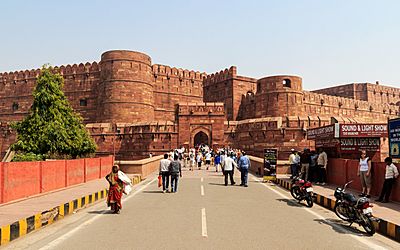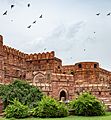Agra Fort facts for kids
Quick facts for kids Agra Fort |
|
|---|---|

Agra Fort
|
|
| Location | Agra, Uttar Pradesh, India |
| Area | 38 ha (94 acres) |
| Architectural style(s) | Mughal |
| Owner |
|
| UNESCO World Heritage Site | |
| Criteria | Cultural: (iii) |
| Inscription | 1984 (8th Session) |
| Map of Agra Fort | |
The Agra Fort is a famous historical fort in the city of Agra, India. People also call it Agra's Red Fort because it is made of red sandstone. It was the main home for rulers of the Mughal dynasty until 1638. That year, the capital city moved from Agra to Delhi.
The fort is like a walled city. Mughal emperor Humayun was crowned here. Later, Emperor Akbar rebuilt much of it from 1565 to 1573. It was also known as "Lal-Qila" or "Qila-i-Akbari." In 1983, the Agra Fort became a UNESCO World Heritage Site. This shows its importance during the Mughal Dynasty. It is about 2.5 kilometers (1.5 miles) northwest of the famous Taj Mahal.
Contents
History of Agra Fort
The early history of Agra Fort is not very clear. However, in the 1400s, the Chauhan Rajputs lived there. Later, Sikandar Khan Lodi made Agra his capital. He built some structures inside the fort.
After the first battle of Panipat in 1526, the Mughals took control of the fort. In 1530, Humayun was crowned inside it. The fort got its current look during the rule of Emperor Akbar (1556–1605).
Mughal Rule and Changes
After the First Battle of Panipat in 1526, Babur stayed in the fort. He even built a baoli (step well) there. His son, Humayun, was crowned in the fort in 1530. But Humayun was defeated in 1540 by Sher Shah Suri. The fort then belonged to the Suri rulers until 1555. Humayun then recaptured it.
Emperor Akbar arrived in Agra in 1558. He saw how important the fort's location was. His historian, Abul Fazl, wrote that the fort was old and ruined. Akbar decided to rebuild it using red sandstone from Rajasthan. About 4,000 builders worked on it every day for eight years. They finished it in 1573.
Akbar's grandson, Shah Jahan, later changed the fort's look. Shah Jahan built the Taj Mahal for his wife, Mumtaz Mahal. Unlike Akbar, Shah Jahan preferred buildings made of white marble. He rebuilt many parts of the fort with white marble. In 1658, Aurangzeb imprisoned Shah Jahan in this very fort.
Later Rulers
The fort was under the Jat rulers of Bharatpur for 13 years. They built the 'Ratan Singh ki Haveli' inside. The Maratha Empire then took over the fort in the early 1700s. The fort changed hands many times between the Marathas and their enemies.
Finally, Mahadji Shinde took the fort in 1785. But the British captured it from the Marathas in 1803. The fort was also a site of fighting during the Indian rebellion of 1857. This rebellion ended the British East India Company's rule in India. It led to direct rule by Britain for a century.
Layout of Agra Fort
The fort covers a huge area, about 380,000 square meters (94 acres). It has a semicircular shape. Its walls are 70 feet high. The walls have strong, round towers called bastions. They also have openings for defense.
There were four gates on its four sides. One gate, the Khizri gate, opened towards the Yamuna river. Two of the most important gates are the "Delhi Gate" and the "Lahore Gate." The Lahore Gate is also known as the "Amar Singh Gate."
The Delhi Gate
The Delhi Gate faces the city on the western side. It is considered the grandest of the four gates. It is a masterpiece from Akbar's time, built around 1568. It was made to improve security and serve as the king's formal entrance. The gate has beautiful designs made with white marble.
A wooden drawbridge was used to cross the moat and reach the gate. Inside, there was another gate called Hathi Pol, or "Elephant Gate." This gate was guarded by two stone elephants with their riders. This added another layer of security. The way the entrance is built, with a drawbridge, a slight slope, and a sharp turn, made it very hard to attack. Attackers could not use elephants to break down the gates easily.
Current Access
The northern part of the fort is still used by the Indian military. Because of this, the Delhi Gate cannot be used by the public. Tourists enter the fort through the Amar Singh Gate.
Buildings Inside the Fort
The fort is very important for its architecture. Abul Fazal wrote that 500 buildings were built inside the fort. They had designs from Bengal and Gujarat. Some of these were pulled down by Shah Jahan to build his white marble palaces. Most others were destroyed by British troops between 1803 and 1862. They built army barracks instead.
Only about 30 Mughal buildings remain on the south-eastern side, facing the river. These include the Delhi Gate, Akbar Gate, and the "Bengali Mahal." The Akbar Darwazza (Akbar Gate) was renamed Amar Singh Gate by Shah Jahan. It looks similar to the Delhi Gate and is also made of red sandstone. The Bengali Mahal is made of red sandstone. It is now divided into the Akbari Mahal and the Jahangiri Mahal.
Historical Sites Inside the Fort
Many interesting historical sites are found within the Agra Fort.
Jahangir's Hauz
The Jahangir's Hauz (tank) was built around 1610 AD. This huge stone tank was used for bathing. It is 5 feet high and 8 feet wide. An inscription in Persian calls it 'Hauz-e-Jahangir'. It was moved several times. Sir John Marshall finally brought it back to Agra Fort. Because of this tank, the nearby palace became known as Jahangiri Mahal.
Shahjahani Mahal
The Shahjahani Mahal (1628–35 AD) is located between the white marble Khas Mahal and the red stone Jahangiri Mahal. It shows Shah Jahan's early efforts to change existing red stone buildings to his taste. This was his first palace in Agra Fort. It has a large hall and an octagonal tower facing the river. The original brick and red stone structure was covered with white plaster. It was then painted with colorful flower designs. The palace once looked completely white, like marble.
Ghaznin Gate
The Ghaznin Gate (1030 AD) originally belonged to the tomb of Mahmud Ghaznavi in Ghazni. The British brought it from there in 1842. They claimed it was made of sandalwood from the Somnath temple. This claim was false. The gate is actually made of local wood from Ghazni. Its style does not match ancient Indian woodwork. There is an Arabic writing on it that mentions Mahmud. The gate was never put back at Somnath. It is now stored in a room inside the fort.
Jahangir's Chain of Justice
This is the place where Mughal king Jahangir set up his 'chain of justice' (Zanjir-i-Adl) around 1605 AD. He wrote that he wanted people to have a direct way to complain. If officials were unfair, people could shake the chain. Its noise would get the king's attention. The chain was made of pure gold. It was 80 feet long and had 60 bells. One end was tied to the Shah-Burj, and the other to a stone post by the river. This was not a myth; travelers saw it. This system allowed anyone, rich or poor, to ask the king for help directly. Jahangir's justice became famous in Indian history.
The Muthamman Burj & Jharokha
The Muthamman Burj (Shah-Burj) and Jharokha (1632–1640 AD) is a palace on the largest tower of Agra Fort, facing east. Akbar first built it in red stone. He used it for jharokha darshan, where he would appear before the public every morning. Jahangir also used it for this purpose. He also placed his 'chain of justice' here. Because of its eight-sided shape, it was called 'Muthamman Burj'. Historians also called it 'Shah-Burj' (the king's tower).
Shah Jahan rebuilt it with white marble around 1632–1640 AD. He also used it for jharokha darshan. It is an octagonal building with five sides facing the river. It has pillars and openings. The eastern side has a special jharokha. This palace is connected to other important buildings like the Diwan-i-Khas and Shish Mahal. The Mughal emperor ruled the country from here. This tower offers a beautiful view of the Taj Mahal. Shah Jahan spent his last eight years (1658–1666 AD) imprisoned in this complex. It is said he died here. His body was then taken by boat to the Taj Mahal for burial.
Shish Mahal
The Shish Mahal (1631–40 AD) was built by Emperor Shah Jahan as a summer palace. Its most special feature is the glass mosaic work on its walls and ceiling. These glass pieces were like mirrors. They sparkled and shone in thousands of ways in the dim light. The glass was brought from Syria. Shah Jahan also built similar glass palaces in Lahore and Delhi.
Images for kids
-
Agra Fort captured by Hemu before the Battle of Delhi (1556)
-
The Ghaznin Gate, taken in 1842 from the tomb of Mahmud of Ghazni in Ghazni, Afghanistan
-
Taj Mahal and Yamuna river
See also
- Jama Masjid
- Fatehpur Sikri
- Lahore Fort
- Red Fort
- Taj Mahal
- List of forts in Uttar Pradesh






























